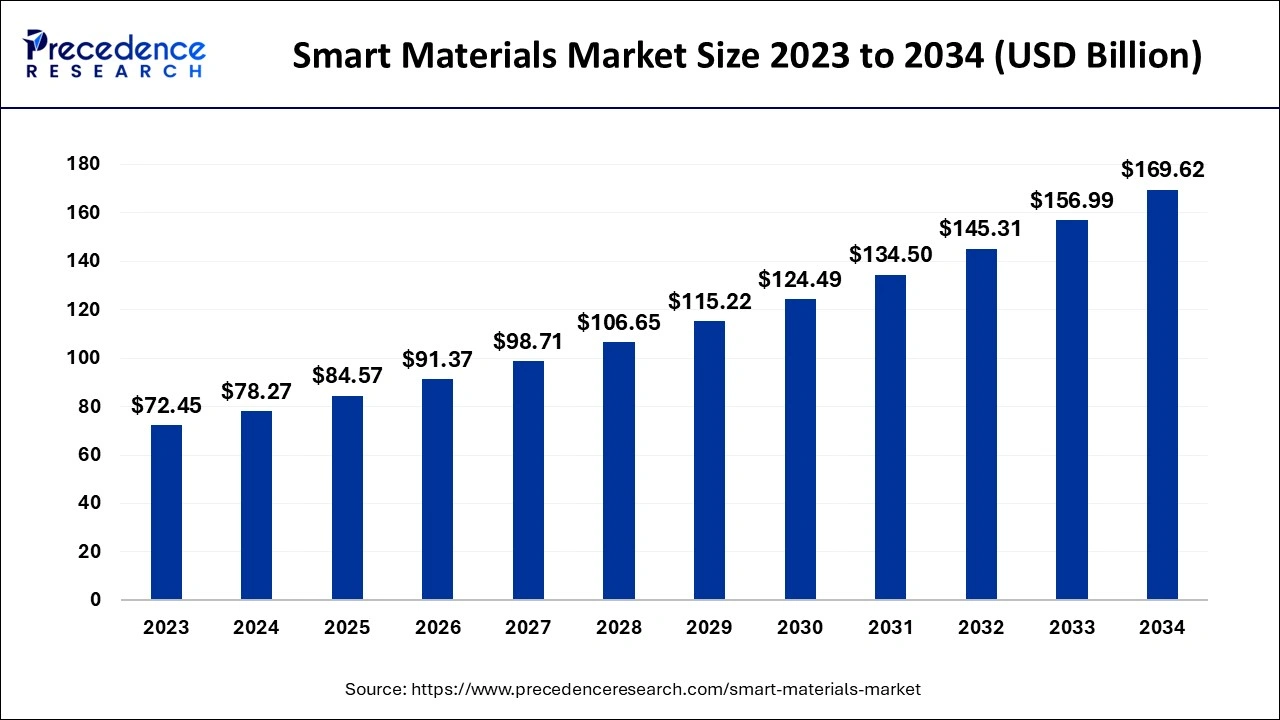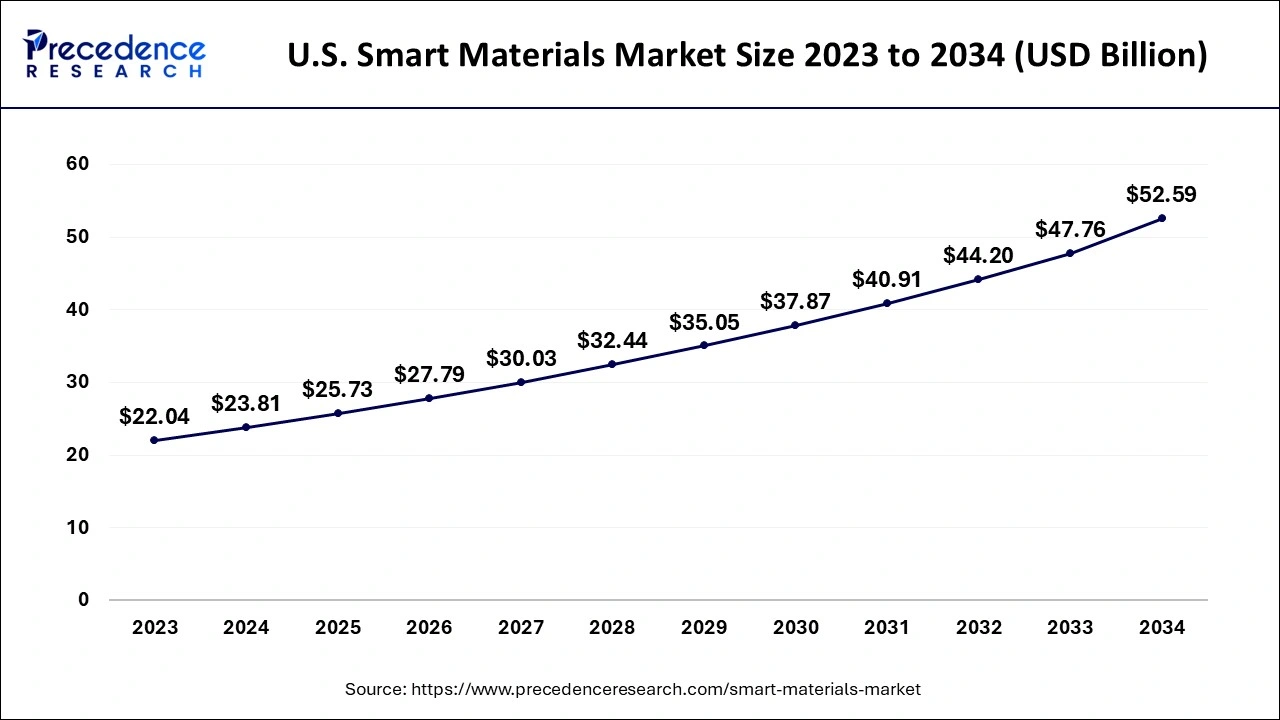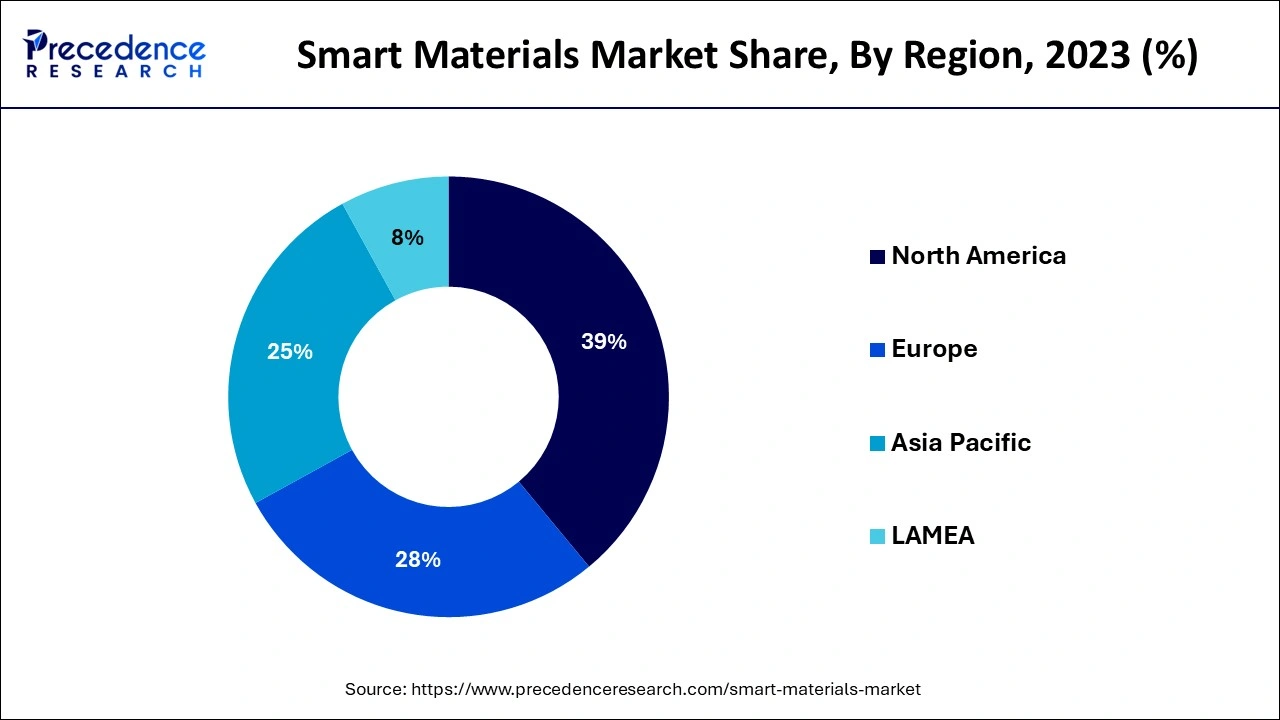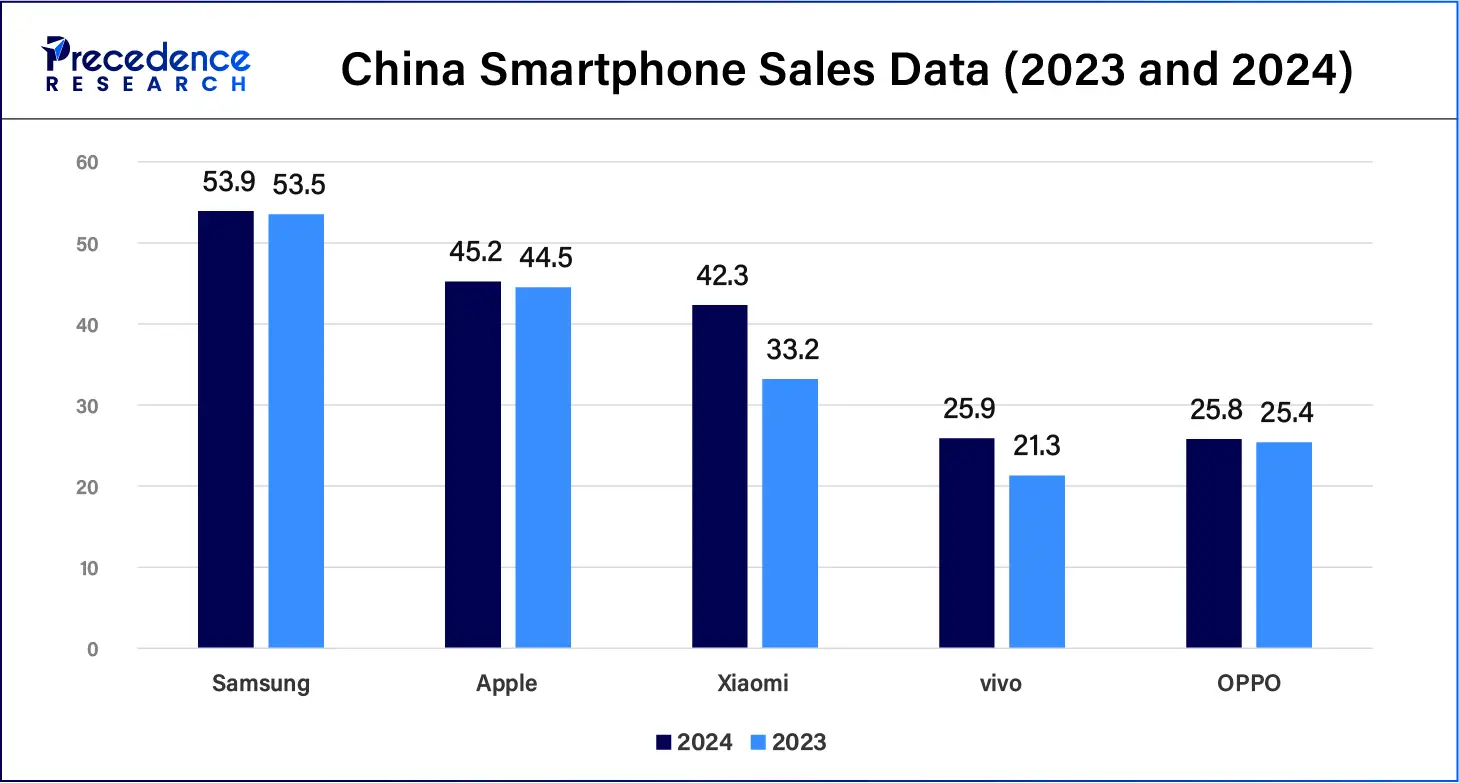May 2025
The global smart materials market size is evaluated at USD 78.27 billion in 2024, grew to USD 84.57 billion in 2025 and is projected to reach around USD 169.62 billion by 2034. The market is expanding at a CAGR of 8.04% between 2024 and 2034. The North America smart materials market size is calculated at USD 30.53 billion in 2024 and is estimated to grow at a fastest CAGR of 8.16% during the forecast period.
The global smart materials market size accounted for USD 78.27 billion in 2024 and is predicted to hit around USD 169.62 billion by 2034, growing at a CAGR of 8.04% from 2024 to 2034. The increasing automation trends are one of the major factors driving the growth of the smart materials market. Industries like consumer electronics, consumer goods, and aerospace are some of the major contributors that raise the need for sensors, smart storage, etc.

The U.S. smart materials market size is exhibited at USD 23.81 billion in 2024 and is anticipated to be worth around USD 52.59 billion by 2034, growing at a CAGR of 8.22% from 2024 to 2034.

North America dominated the global smart materials market in 2023. The dominance of the region is attributed to the well-established technologies and infrastructure in countries like the United States and Canada. The government also provides regulatory support in innovation through R&D that helps their nation to grow as a world leader. Universities are major sources that focus on R&D to innovate new technologies that might help the growth of the smart materials market. Additionally, these countries have advanced defense infrastructures that lead to the increasing demand for these materials.

Asia Pacific is anticipated to grow significantly in the smart materials market during the forecast period of 2024 to 2034. The growth of the region is attributed to the rapid infrastructure development in countries like China, India, and Japan. The region is witnessing rapid urbanization, which brings many opportunities throughout multiple sectors that demand smart materials. Countries like China also focus on improving their defense sector, creating multiple opportunities in the region. China is also the leader in electronics and automobiles, which has increased the significant demand for smart materials in the region.
China’s Electronic Industry

Smart materials refer to active materials that have the capability of changing their properties after being exposed to external stimuli such as electrical or magnetic fields, pressure, temperature, light, etc. These materials also return to a normal state after removing the stimulus. This makes the materials adaptable to working in various environmental conditions for their use in a variety of applications. Some of the smart materials are shape memory alloys, which are mostly used in biomedical devices. The smart materials market is witnessing significant demand due to the rising need in the aerospace industry to require safety in their aircraft.
How Can AI Help in the Smart Materials Market?
The emergence of technologies like artificial intelligence (AI) and machine learning (ML) has significantly helped accelerate product design in multiple industries, including the smart materials market. AI algorithms analyze huge datasets, which include the properties of the materials and how they can be used efficiently in various applications. AI-based technology helps professionals to find better materials that can fit into a specific product. Additionally, the emergence of robotics in the manufacturing industry has significantly helped in improving production efficiency without the need for constant human intervention. AI-based sensors help predict various parameters, which include maintenance or any threat that could be harmful.
| Report Coverage | Details |
| Market Size by 2034 | USD 169.62 Billion |
| Market Size in 2024 | USD 78.27 Billion |
| Market Size in 2025 | USD 84.57 Billion |
| Market Growth Rate from 2024 to 2034 | CAGR of 8.04% |
| Largest Market | North America |
| Base Year | 2023 |
| Forecast Period | 2024 to 2034 |
| Segments Covered | Product, Application, and Regions |
| Regions Covered | North America, Europe, Asia-Pacific, Latin America and Middle East & Africa |
Expansion of the electronic industry
Rapid urbanization and rising internet penetration have been major growth factors in the electronics industry. These factors lead to the demand for advancements in electronic devices like smartphones, tablets, and especially wearable technologies. The majority of these devices are carried in day-to-day life, raising the need for lightweight materials. These materials help in miniaturization while maintaining the overall functionality. These factors have led to the development of multiple devices and a tough business environment, which creates more demand for smart materials from different electronic manufacturing companies.
Expansion of medical applications
The increasing focus on adopting the latest technologies in the healthcare sector is one of the major drivers of the smart materials market. The emergence of new diseases is leading to the need for advancement in the medical sector. Smart materials like piezoelectric and shape memory alloys can be used in developing diagnostic equipment. Additionally, the rise of distance diagnosis is one of the major factors driving the need for wearable devices that help in remote patient monitoring. Many health organizations and governments have improved their focus on healthcare to tackle new diseases and health conditions.
Higher costs
The smart materials market has grown efficiently in recent years, but some factors still tend to affect the market growth. The development of these materials relies heavily on new technologies, which affect its growth in underdeveloped regions. Purchasing these materials and devices can be financially unaffordable for these people, which might restrict the market flow. Many developing countries need a high defense infrastructure, which acts as a barrier.
Increasing research and development (R&D)
The use of smart materials in various applications across multiple industries has constantly led to enhanced and durable products using smart materials. This rising demand is leading towards R&D that helps improve the functionality and durability of these materials, leading to enhanced services in various applications. Many industries are leading towards the need for specific conditions that also lead to creating tailored and specific industry-based solutions.
Increasing need for energy storage and harvesting
The increasing need for energy sources like wind and solar are gaining significant popularity which raises the need for smart materials that help them in enhancing their efficiency. The emergence of wearable technology is also one of the major contributors that is expected to create multiple opportunities in the smart materials market in the upcoming years. Additionally, the increasing demand in the automotive sector is expected to drive growth due to the increasing need for improvements in electrical vehicle battery technology.
The piezoelectric materials segment registered the largest share of the smart materials market in 2023. They are dielectric materials that generate mechanical charge when mechanical stress is applied to them, which makes converting energy easier. These materials are mostly used in sensors, medical devices, and other vibration-based systems.The dominance of the segment is attributed to the ability of the materials to be used in multiple applications, which is raising demand and increasing its popularity, especially in sensors. Their capability of handling movements and location makes it a suitable option in the healthcare sector.
The shape memory materials segment is anticipated to grow rapidly in the smart materials market during the forecast period of 2024 to 2034. The growth of the segment is attributed to the unique capability of these materials that helps them remember their original shape after getting exposed to heat or current.
These materials are gaining popularity due to their adoption in creating biomedical applications like surgical tools. The increasing demand for these devices is attributed to the rising population and the need for advanced technologies in the healthcare sector. The constant focus on innovating these materials has also made them affordable and can be used in various industries like automotive and aerospace.
The actuators & motors segment stood the dominant in the global smart materials market in 2023. The application refers to the conversion of hydraulic or pneumatic energy into a mechanical motion. In the smart material application, these devices perform tasks using various types of smart materials. The dominance of the segment is attributed to the high demand for these devices across multiple industries. The application of these devices in various industries helps in controlling their systems efficiently. Their efficiency in performing in the healthcare and defense sector drives more investments and attention from the companies.
The structural materials segment is expected to register the fastest growth in the smart materials market during the forecast period of 2024 to 2034. These materials are specifically designed to enhance the durability of the structures. The growth of the segment is attributed to its increasing use in the civil and automotive industries, which need self-healing polymers. The rapid rise in infrastructure development is also one of the major reasons for the need for structural materials in constructing buildings, roads, and other concrete-based works. This is significantly raising the need for quality materials, especially in the growing economies.

Segments Covered in the Report
By Product
By Application
By Geography
For inquiries regarding discounts, bulk purchases, or customization requests, please contact us at sales@precedenceresearch.com
No cookie-cutter, only authentic analysis – take the 1st step to become a Precedence Research client
May 2025
February 2025
April 2025
January 2025